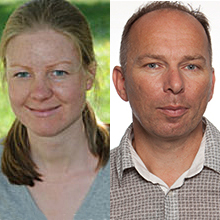Dec 4 2014
Scientists at Helmholtz Zentrum München, in collaboration with colleagues from the TU München and the Karlsruhe Institute of Technology (KIT), have studied how soil microorganisms react to climatic change. Their result: Extreme weather events such as long periods of drought and heavy rainfall have a strong impact on the metabolic activity of microbes. This may lead to a change in the nutrient balance in soils and, in extreme cases, may even increase greenhouse gas emissions like nitrous oxide to the atmosphere concentrations.
 Dr. Silvia Gschwendtner, Prof. Dr. Michael Schloter | Source: HMGU
Dr. Silvia Gschwendtner, Prof. Dr. Michael Schloter | Source: HMGU
In order to observe the impact of climate change on soil microorganisms under as natural conditions as possible, the scientists transferred intact young beech seedlings from a cool, wet, northwest-exposed site of a slope approximately corresponding to present climatic conditions to a warmer site exposed to the southwest. This transfer simulated temperature and precipitation profiles as can be expected from climate change. “We tried to keep initial soil type and nutrient content sin soil as comparable as possible to avoid additional factors influencing our data”,” said Prof. Dr. Michael Schloter, head of the Research Unit Environmental Genomics (EGEN) at Helmholtz Zentrum München. “In addition to these natural changes due to the transplantation of the trees, we exacerbated the scenario by simulating long periods of drought followed byheavy rainfall,” he added.
To determine the dynamics of the soil microflora, the researchers studied marker genes of microorganisms that are typically involved in nutrient turnover. They found that already a transfer from NW to SW without simulating extreme weather conditions led to a drastic change in metabolic activity and in the composition of the microorganisms. “Under extreme climatic conditions these effects were even more pronounced,” said Dr. Silvia Gschwendtner (EGEN), who carried out the research project. The findings indicate that the activity of microorganisms primarily involved in denitrification is positively stimulated by the chosen conditions. “This has an impact on the competition between plants and microorganisms for nitrogen,” Gschwendtner explained. “Furthermore, this may also lead to increased emission rates of the climate-relevant greenhouse gas N2O.”
Further information
Denitrification: In denitrification, the nitrate present in the soil available to plants is converted to gaseous nitrogen and to nitrogen oxides.
Publication:
Gschwendtner, S. et al.(2014)Climate change induces shifts in abundance and activity pattern of bacteria and archaea catalyzing major transformation steps in nitrogen turnover in a soil from a Mid-European beech forest, PLOS ONE, doi: 10.1371/journal.pone.0114278